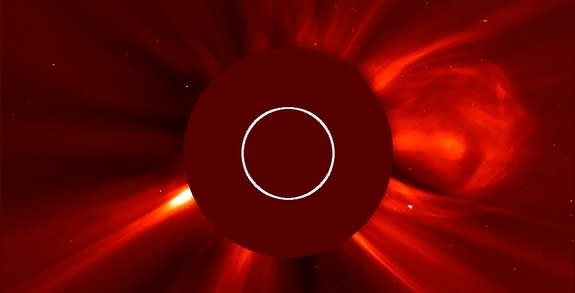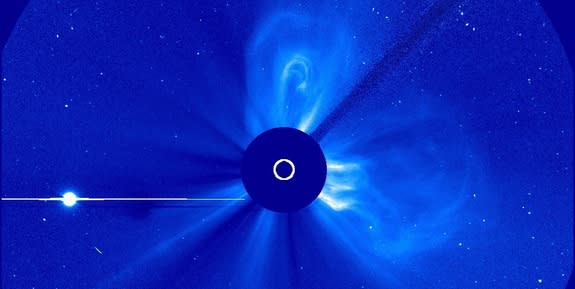Sun Fires Off 3 Solar Eruptions Toward Mercury
The sun has unleashed a trio of solar eruptions toward the planet Mercury in recent days, solar storms that may pass one NASA spacecraft while dealing a glancing blow to another, NASA officials say.
The three flares erupted from the sun over the span of two days, and belched waves of plasma and charged particles — called coronal mass ejections (CMEs) — that are now heading toward Mercury, NASA officials said in a statement. The combined CMEs are expected to pass the agency's Messenger probe, which has been orbiting the planet closest to the sun since March 2011, but may deliver a glancing blow to the Stereo-A spacecraft, which circles Earth while training its eyes on the sun.
"The Messenger and Stereo mission operators have been notified," NASA officials wrote in an update. "There may be some particle radiation associated with this event, which in the worst case scenario can impact computer electronics on board interplanetary spacecraft. If warranted, operators can put spacecraft into safe mode to protect the instruments from the solar material." [Amazing Solar Storms of 2013 (Photos)]
The first CME erupted at 2:54 a.m. EDT (0655 GMT) on April 20. Two additional CMEs followed the next day, at 3:54 a.m. EDT (0754 GMT) and 12:39 p.m. EDT (1639 GMT). All three clouds of superhot plasma were blasted from the sun at speeds greater than 1.8 million miles per hour (2.9 million kilometers per hour).
When aimed directly at Earth, the strongest solar flares and eruptions can pose a threat to satellites and astronauts in space, and interfere with navigation, communication and power infrastructure on the surface.
NASA's Stereo-A is one of a pair of twin space probes that monitor solar weather events. The Stereo spacecraft (short for Solar Terrestrial Relations Observatory) were launched in 2006.
The Messenger spacecraft completed the first full map of Mercury's surface last month. The probe's primary mission ran through March 2012, but was granted a one-year extension.
The sun's activity ebbs and flows on an 11-year cycle, and solar weather events are expected to increase this year as the current cycle ramps up toward the solar maximum. The current solar weather cycle is known as Solar Cycle 24.
Follow Denise Chow on Twitter @denisechow. Follow us @Spacedotcom, Facebook or Google+. Originally published on SPACE.com.
Copyright 2013 SPACE.com, a TechMediaNetwork company. All rights reserved. This material may not be published, broadcast, rewritten or redistributed.



